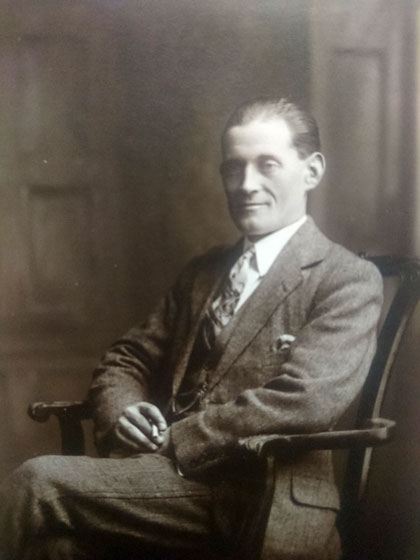Sergeant Thomas Robert Dickson

Thomas Robert Dickson was born on 24 September 1891 at Drummee, Enniskillen, County Fermanagh, the last of four children of farmer Robert Dickson and his wife Anne (née Johnston). By the time of the 1911 Census he was living at Drummee with his parents and a sister and working as a farmer.
Dickson enlisted in the 6th (Inniskilling) Dragoons Service Squadron on 11 November 1914 (No. UD/166). According to the Fermanagh Times, "he had to undergo a severe operation in Dublin before he was accepted by the Military Medical Authorities for the Army."
On 6 October 1915 he embarked for France with his squadron, which was then serving as divisional cavalry to the 36th (Ulster) Division.
The Fermanagh Times of 15 June 1916 reported that:
Corporal T. Dickson, Drumee, and Trooper H. Jones, Wellington Place, Enniskillen, both of the 6th Inniskilling Dragoons (Ulster Division) are at present home on short leave from the front.
In June 1916 the Inniskilling squadron joined C and F Squadrons of the North Irish Horse to form the 2nd North Irish Horse Regiment, serving as corps cavalry to X Corps. On 5 July 1916, while engaged on salvage duty at Aveluy Wood, Dickson was wounded when his party came under heavy artillery fire. According to the regimental diary:
Orders were received from A.P.M. 36th Division at 9 am for the two troops dismounted to report to Capt O'Neill at Lancashire Dump for salvage duty. They carried out this duty bringing in equipment, rifles etc till 1 pm. The men had dinner and were just turning out again when Lieut Seymour received orders from 36th Division to return to Regtl Head Quarters. The men had just started to saddle up when a heavy bombardment of both high explosive, shrapnel & machine guns was concentrated on the Wood. The intensity of the fire necessitated Lt Seymour giving orders for the men to take shelter in some old dugouts & trenches close by. The bombardment lasted for 3/4 of an hour & then slackened but did not entirely stop. Up to now one horse was killed & four wounded. The men were then ordered to saddle up & lead their horses thro' Wood out on to the road and were waiting for the others to join up when the bombardment opened much heavier than previously especially on that part of the road where the men were waiting. Lt Seymour moved off up the road leaving 2/Lt Matthews & Sergt McIlvoy to round up the stragglers in the wood, as by this time horses were very restive and almost unmanagable. Lt Seymour with his party had reached about 1 mile along the road & turned down a lane leaving the horses in charge of Sergt Quinn. Almost immediately a heavy fire was brought to bear on the horses and Sergt Quinn was wounded. The horses stampeded in every direction, some back to Aveluy Wood. Eventually Lt Seymour was able to round up most of this party & got to Senlis. Lieut Matthews & Sergt McIlroy remained behind. Our losses numbered 16 horses killed or wounded and 2 missing. 2/Lt Matthews was wounded severely in the knee from high explosive and Pte Downes, Nicholl, Gourley wounded (hosp) and Ptes Buchanan, 195 Campbell, Totton, 105 Craig, Cpl Dickson, 209 Robinson slightly wounded (duty).
Dickson returned to his squadron soon after.
In August-September 1917 the 2nd NIH Regiment was disbanded and its men were transferred to the Royal Irish Fusiliers, an infantry regiment. Most, including Dickson, were transferred on 20 September and posted to the 9th (Service) Battalion – renamed the 9th (North Irish Horse) Battalion – joining it in the field at Ruyaulcourt five days later. Dickson was issued regimental number 41120 and posted to B Company.
He probably saw action with the battalion at the Battle of Cambrai in November and December 1917, and perhaps also during the retreat from St Quentin from 21 to 28 March 1918.
Dickson was wounded in the chest between 11 and 18 April 1918 in the actions between Wulverghem and Kemmel on the Ypres front. Evacuated to the UK for treatment, in early 1919 he re-enlisted in the Royal Irish Fusiliers (No.7042386). He was discharged on 3 November 1920.
Dickson was granted a pension due to a wound to his left shoulder – whether this was the injury inflicted in April 1918 is not know at present. His level of disability was assessed at 50 per cent in April 1921. He was treated for a period of time in the Special Surgical Hospital in Du Cane Road, London.
After the war Dickson resumed farming at Drummee. He later worked as a contractor and company director. On 27 June 1928 he married Harriet Emily Britton in St Barnabas Church, Smithfields, London. He died in the Erne Hospital on 20 July 1967 and was buried in the Rossorry Churchyard, Enniskillen.

First image, from the Fermanagh Times in July 1917, courtesy of Nigel Henderson, Researcher at History Hub Ulster. Second image sourced from Ancestry.com Public Member Trees – contributor Matthew Mulligan.
This page last updated 30 October 2023.
